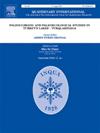肋状冰碛的特征特征及形成过程
IF 1.8
3区 地球科学
Q3 GEOGRAPHY, PHYSICAL
引用次数: 0
摘要
肋状冰碛是一种冰川下形成的冰碛地貌类型,分布于芬诺斯坎迪亚、爱尔兰、冰岛和北美。它们以一组冰碛垄的形式出现,这些冰碛垄的方向与最新的冰流方向相反。关于肋状冰碛的起源和形成的理论自20世纪50年代以来已经提出,但仍在争论中。本文将讨论和回顾肋状冰碛的特征和形成理论,重点介绍最新的观测结果。根据大量已发表的研究,很明显,肋状冰碛的形成发生在冰下条件下的活跃冰运动期间,i)肋状冰碛通常形成广泛的冰碛脊场,ii)冰碛脊具有均匀的横向山脊方向,iii)冰碛中鹅卵石在冰流方向上良好而均匀的方向,iv)内部结构包括活动分层,剪切结构,砂带,冰碛垄,冰碛垄,冰碛垄,冰碛垄,冰碛垄,冰碛垄,冰碛垄,冰碛垄,冰碛垄,冰碛垄,冰碛垄,冰碛垄,冰碛垄,冰碛垄,冰碛垄,冰碛垄和冰碛垄。(5)上部土层局部细粒物质和岩屑富集。一个值得注意的特征,特别是在芬兰观察到的,是肋状冰碛表面出现了巨大的、棱角分明的巨石。它们的组成变化迅速,反映了下垫基岩的组成,表明冰川运输距离很短。肋状冰碛通常可以在最后的大陆冰川中心附近找到。其形成过程有利于寒、暖冰川接触带的冰下条件。合适的形成条件似乎是在寒冷的新仙女木期结束时快速气候变化的结果。本文章由计算机程序翻译,如有差异,请以英文原文为准。
Characteristic features and formation processes of ribbed moraines
Ribbed moraine is a subglacially formed moraine landform type which can be found from Fennoscandia, Ireland, Iceland and North America. They occur as a group of moraine ridges which have oriented transversal to the latest ice flow direction. Theories for origin and formation of the ribbed moraines have been presented since 1950s but are still under debate. In this paper, characteristic features and formation theories of ribbed moraines will be discussed and reviewed with emphasis on the latest observations. Based on numerous published studies, it is evident that the formation of ribbed moraines has occurred during active ice movement under subglacial conditions, i) where ribbed moraines have typically formed extensive moraine ridge fields, ii) where the moraine ridges have a uniform transverse ridge orientation, iii) good and uniform orientation of pebbles in the moraine in the direction of the ice flow, and iv) an internal structure including active stratification, shear structures, sand banding, and v) enrichment of local fine material and rock fragments in the uppermost till layer. One notable feature, particularly observed in Finland, is the occurrence of large, angular boulders on the surface of ribbed moraines. Their composition varies rapidly, reflecting the composition of the underlying bedrock and indicating a very short glacial transport distance. Ribbed moraines can be typically found in the close vicinity of centres of the last continental glaciers. The formation process favoured certain subglacial condition in the contact zone of cold-based and warm-based glaciers. It seems that suitable formation conditions could have arisen as a result of rapid climate changes at the end of the cold Younger Dryas period.
求助全文
通过发布文献求助,成功后即可免费获取论文全文。
去求助
来源期刊

Quaternary International
地学-地球科学综合
CiteScore
5.60
自引率
4.50%
发文量
336
审稿时长
3 months
期刊介绍:
Quaternary International is the official journal of the International Union for Quaternary Research. The objectives are to publish a high quality scientific journal under the auspices of the premier Quaternary association that reflects the interdisciplinary nature of INQUA and records recent advances in Quaternary science that appeal to a wide audience.
This series will encompass all the full spectrum of the physical and natural sciences that are commonly employed in solving Quaternary problems. The policy is to publish peer refereed collected research papers from symposia, workshops and meetings sponsored by INQUA. In addition, other organizations may request publication of their collected works pertaining to the Quaternary.
 求助内容:
求助内容: 应助结果提醒方式:
应助结果提醒方式:


